“Jist Shoot ‘em Refugees to Mars!”
- Christian Hain
- Oct 14, 2016
- 5 min read
Updated: Apr 1, 2020
(Berlin.) The somewhat radical idea is not taken from The Donald’s election manifesto, nor is there any need to cry for a boycott of this trivial little online publication. No, it’s Turkish artist Halil Altindere who has been imagining new ways to provide “space” for refugees, and like it's the case with all Utopias, this one too tells more about the society it has been devised in, than about any feasible project.
It all starts (“launches”) with photographs in the shop windows of Neuer Berliner Kunstverein: A man guiding two children through a rocky red landscape, wearing space suits and gazing at asteroids that fly rather low. Once inside, visitors are confronted with Arab calligraphy and a toy spaceman, heavily moustachioed. In 1987, Muhammed Ahmed Faris became the first Syrian citizen to contemplate the earth from above, sent on a trip to orbit with Soviet cosmonauts. Fascinated with his story and the Syrian question today, Halil Altindere asks: What if all Syrians followed his example; the non-fighting ones at least?
The show’s first part brings photos and paintings of Faris surrounded by colleagues and family. Blue neon tubes between frame and image pose a “futuristic” counterpoint to the traditional Arab/Soviet image style. It almost looks how you’d imagine an art collection on board the USS Enterprise NCC 1701-x. A sci-fi soundtrack highlights the darkness around the projection of a spacy screen saver - well: NASA pics. Disco ball like light dots rain on the screen and a sculpture group in front. Here as almost everywhere else, it’s only the cosmonaut and his(?) children, but not a woman in sight. When she finally appears, she's un-veiled, which might upset some. It reminds you: A space suit is like a burka for all, another problem solved.
Proceeding deeper into (exhibition)space, a stellar tapestry sets the atmosphere for a Mars Rover like buggy labelled “Palmyra”, CGI of the Mars colony-to-be, and flowers in a galaxy proof steel pot. The text explains how thanks to this box, plants may grow without earth, it's got everything they need. If Altindere is smart, he asked for money before placing the manufacturer’s name so prominent in the show.
All parts come together in a film that starts with a portrait of Muhammed Faris who fled Syria in 2012, at the time holding a high position in the nation’s air force. He describes the hardships he’s endured on the way out, and he went no farther than Turkey, not risking his life and his family’s on the long journey to Europe. His advice to compatriots is to ‘raise your children in our culture, the way of life in the homeland, and be prepared for the day you go back’. It’s uncertain how many think alike and how many come to stay in the promised land painted by professional escape helpers, in an Utopian version of Europe, the smallest continent. Who leaves his home does so forced by need, but also to pursue a dream, and that dream often makes a return home only a remote possibility. Slowly, fiction, or future, enters the film. The new project is to leave earth and settle on Mars - “there, where no man has any property, all men zealously pursue the good of the public” (Thomas More, Utopia, a handful of centuries ago). Already international treaties seek to keep space communal (how many citizen are aware of this, and who exactly signed those treaties; on whose behalf?).
Interviews with NASA staff, lawyers and even architects spin the idea further. Mars is the nearest - journey takes but a year, that’s less than some trips to Europe do - planet with an agreeable climate, etc. We learn about the planet's wealth in iron that could be harvested for the beginning of another Iron Age(?!), and a fleet of spaces shuttles to carry supplies. Later, everything should be 3D printed on-site. People would, of course, be forced to live under “earth”, or in termite mounds to protect them from the dangers (these).
Needless to say, all has been filmed on earth. It will probably not surprise you, but: Mars is not a solution for the refugee crisis. Halil Altindere does not mean it literally, he aims at earthly problems; when the situation seems hopeless people find refuge in a dream. Everything is here on earth, but the circumstances make not everything accessible to everyone. Syrian desperation has reached a point when all options are considered, all promises are believed. It seems not even impossible that the civil war will rage on for the next five decades, about the time needed to make a Mars colony a realistic option. When the problems are not solved where you are (/on earth), you look elsewhere. First of all this concerns neighbouring countries like Turkey, where Faris went to. Then, potentially, the rest of the world. Then, what’s next?
Don’t let the press release frighten you away with its talk of “migration, identity and gender” being Halil Altindere's favourite topics, that gibberish you read in about fivehundredandfiftyfive press releases every weekend. This show is not just another repetition of ever the same simplistic ideology that everyone in the not so pluralistic art world is expected to believe in. Of course, Altindere does not see the refugee masses as a real-life Zombie apocalypse, but neither does he exploit dead babies forced on a voyage to their parents’ vision of paradise. There’s a problem, there’s desperation and a hopeless dream that cannot become reality right now.
A nice technological gimmick, NBK also offers VR glasses to explore the colonial future. This was the first time I’ve tried some of those, and well, shut up and take my money. Walk around here and be someplace else, that's nice indeed (also a metaphor for talking about earth in SciFi). Slightly irritating not to see my feet in the Marsian sands when looking down. Also missed a gun (yet, thinking about it: is this really the future of gaming? Without cuddling into a comfy sofa? Without talking and drinking beer simultaneously, the only form of multitasking men are capable of? Immersion is not always sought for.) And you might run into some very real obstacles in this world while walking around on Mars.
Two more exhibitions at NBK, but don’t expect too much from your free entry. Austrian Gerwald Rockenschaub added some colour lines to the facade, and Iraqi-German Natascha Sagr Haghighian shows a scientific installation that was out of order on my visit (It’s supposed to manipulate video chats in a way that participants always face the camera – remember, TV workers are explicitly advised not to do this because it’s quite disconcerting. The installation further points to a patented, gen-manipulated, mouse, a life form that nobody wants to focus directly, either).
Halil Altindere, Space Refugee, 15 September-6 November 2016, NBK

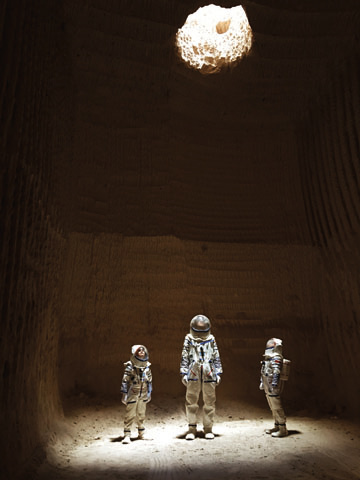

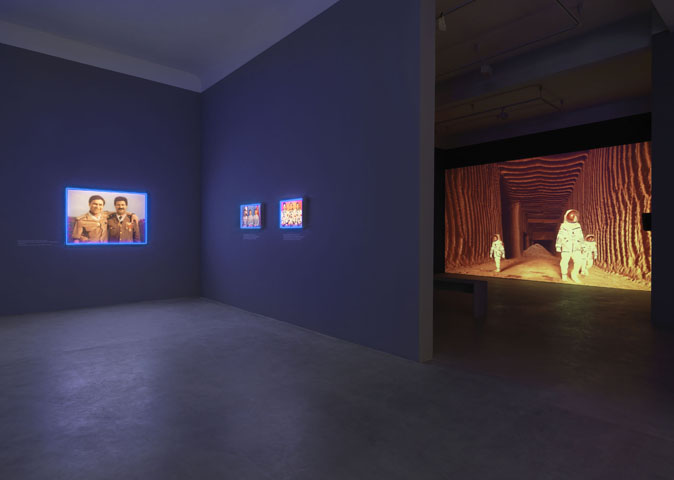

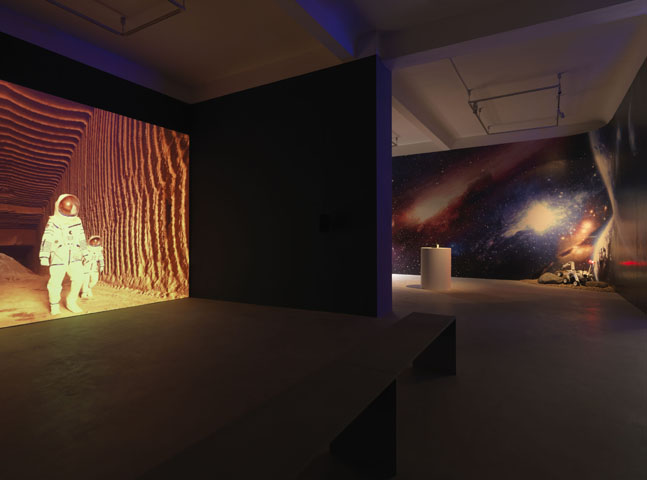

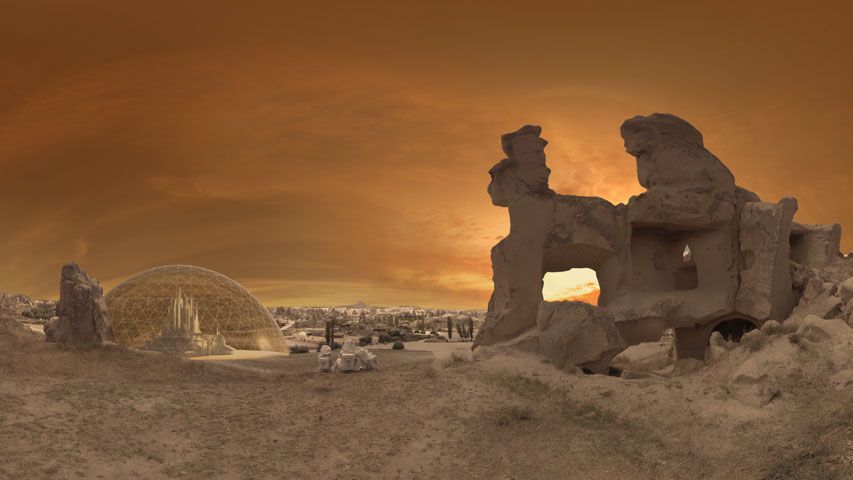

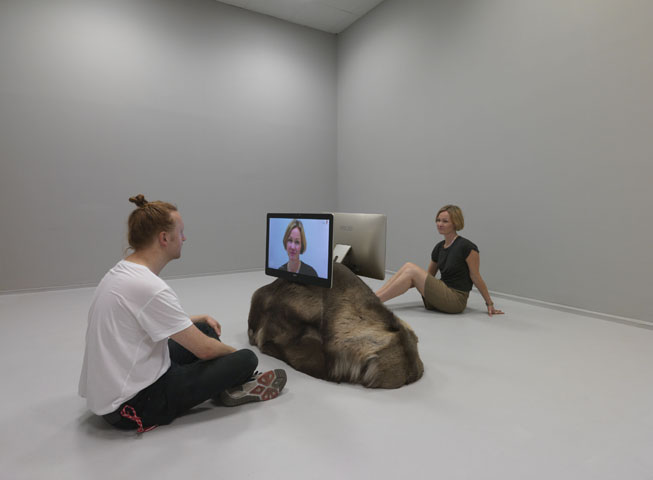
Comments